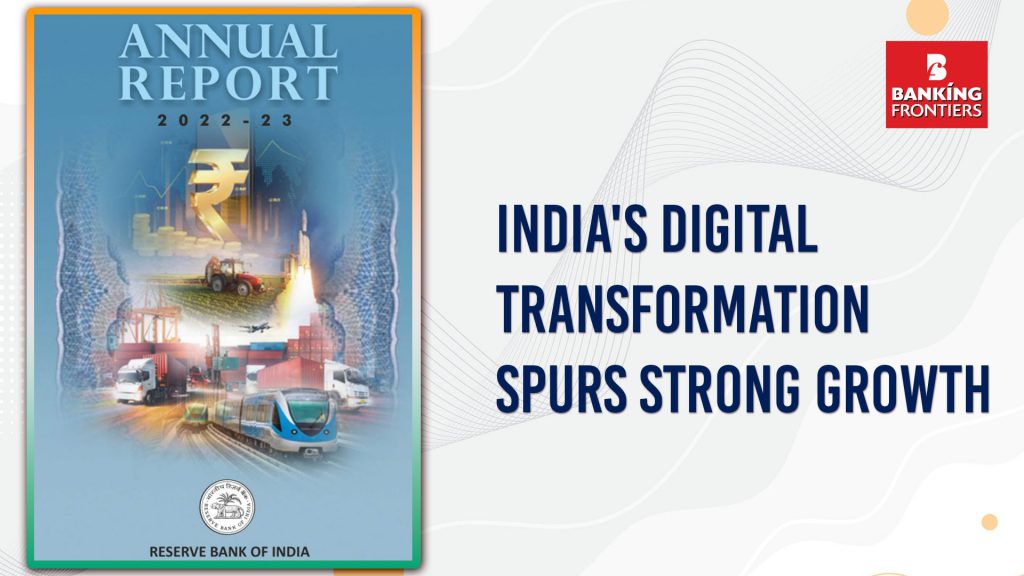
In its Annual Report for 2022-23, the Reserve Bank of India has highlighted the positive impact of India’s wave of digital transformation, stating that the country has emerged stronger as a result. The report covers the period from April 2022 to March 2023.
One notable achievement mentioned in the report is the double-digit credit growth experienced by the banking system during the year. The efforts made to augment capital and improve asset quality, coupled with the onset of a fresh lending cycle since the second half of 2021-22, led to a significant increase in credit across all major sectors. This growth is seen as a reflection of India’s expanding digital landscape and enhanced accessibility to financial services.
The asset quality of scheduled commercial banks (SCBs) continued to improve, with the gross non-performing assets (GNPA) ratio and net non-performing assets (NNPA) ratio declining and the quarterly slippage ratio cooling off. The provisioning coverage ratio (PCR) also steadily increased. Net interest margin (NIM) witnessed an improvement, reflecting the higher degree of transmission of monetary policy to lending rates than to deposit rates in the rising interest rate cycle. Consequently, profit after tax (PAT) registered strong growth. Return on equity (RoE) and return on assets (RoA) for SCBs improved further during the year.
CBDC, Digital Payments
Reserve Bank introduced its Central Bank Digital Currency (CBDC) in phases during the year, with the launch of pilots for the Digital Rupee (e`) in the wholesale and retail segments. As on March 31, 2023, there were 84 DBUs functioning across the country. India has emerged stronger and more resilient from the pandemic, partly due to the wave of digital transformation. Transactions routed through digital modes recorded a marked expansion in 2022-23 over and above the strong growth witnessed a year ago. In 2022-23, total digital payments recorded growth of 57.8% and 19.2% in volume and value terms, respectively, on top of growth of 63.8% and 23.1%t, respectively, in the previous year. India outpaced other nations to emerge as the largest player in real-time transactions at the global level, with a 46% share in 20222. The strong penetration and growth in Unified Payments Interface (UPI) were buoyed by rapid merchant onboarding, growing digital awareness and policy thrust on continuous enhancements in the scope and reach of payment systems.
Sharp upticks witnessed in the Aadhaar Payments Bridge System (APBS) and the National Automated Clearing House (NACH) in 2022-23 attested to the diffusion of digital payments in the rural and semi-urban areas of the country, in part owing to the positive nudge provided through government cash transfers going digital. With the recovery in the tourism and hospitality sectors, the card industry regained lost momentum, with monthly spending remaining above 1.6 lakh crore throughout the year.
The Reserve Bank released the Payments Vision 2025 during the year with the theme E-Payments for Everyone, Everywhere, every time promising to further elevate India’s payment systems to empower every user with safe, secure, reliable, accessible, affordable and efficient payment options.
The UPI Lite was introduced to facilitate small value transactions in offline mode using UPI through an on-device wallet. Linking of RuPay credit cards to UPI was permitted to deepen usage by broadening the financial products linked for payment processing. The introduction of single block multiple debits in UPI enhanced the capabilities for merchant payments. The UPI was also extended to non-resident Indians (NRIs) and foreign nationals for undertaking merchant payments in India. The linking of UPI with PayNow of Singapore helped facilitate low-cost fund transfers and remittances between the two countries. The scope of Bharat Bill Payment System (BBPS) was expanded to include all categories of payments and collections
Economy: Review And Prospects
Available projections suggest a weaker outlook for the global economy in 2023 and 2024 after the resilience it exhibited to multiple and often overlapping shocks in 2022. Amidst strong global headwinds, the Indian economy is expected to have recorded a growth of 7.0% in real GDP in 2022-23. In the second half of 2022-23, the pace of year-on-year growth moderated because of unfavourable base effects, weakening private consumption demand caused by high inflation, the slowdown in export growth and sustained input cost pressures. Like many other economies, India also experienced a surge in inflation during 2022-23. The Reserve Bank adopted a nuanced and nimble-footed approach to liquidity management in sync with the change in the stance of monetary policy. Financial markets experienced bouts of volatility in 2022-23, as geopolitical tensions intensified, interest rate hikes by the US Fed turned aggressive and the global growth outlook deteriorated, dampening investors’ sentiments. The management of government finances was guided by the need for prudence.
Global growth is expected to slow down in 2023 and may remain subdued in the medium run. The crowding-in effects of sustained increase in government capex over recent years is expected to spur higher private investment in 2023-24. On the back of sound macroeconomic policies, softer commodity prices, a robust financial sector, a healthy corporate sector, continued fiscal policy thrust on quality of government expenditure, and new growth opportunities stemming from global realignment of supply chains, India’s growth momentum is likely to be sustained in 2023-24 in an atmosphere of easing inflationary pressures.
RBI instructs banks to set up infrastructure for smooth exchange of Rs 2,000 notes







